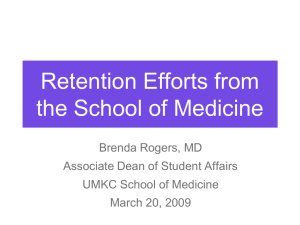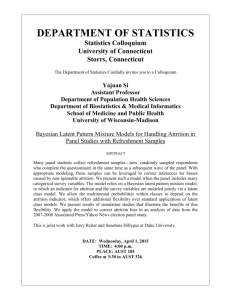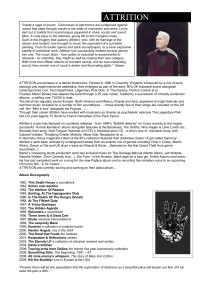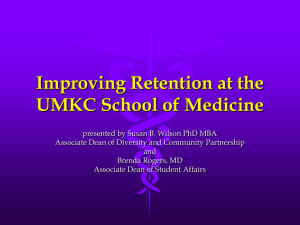PERSPECTIVES
advertisement
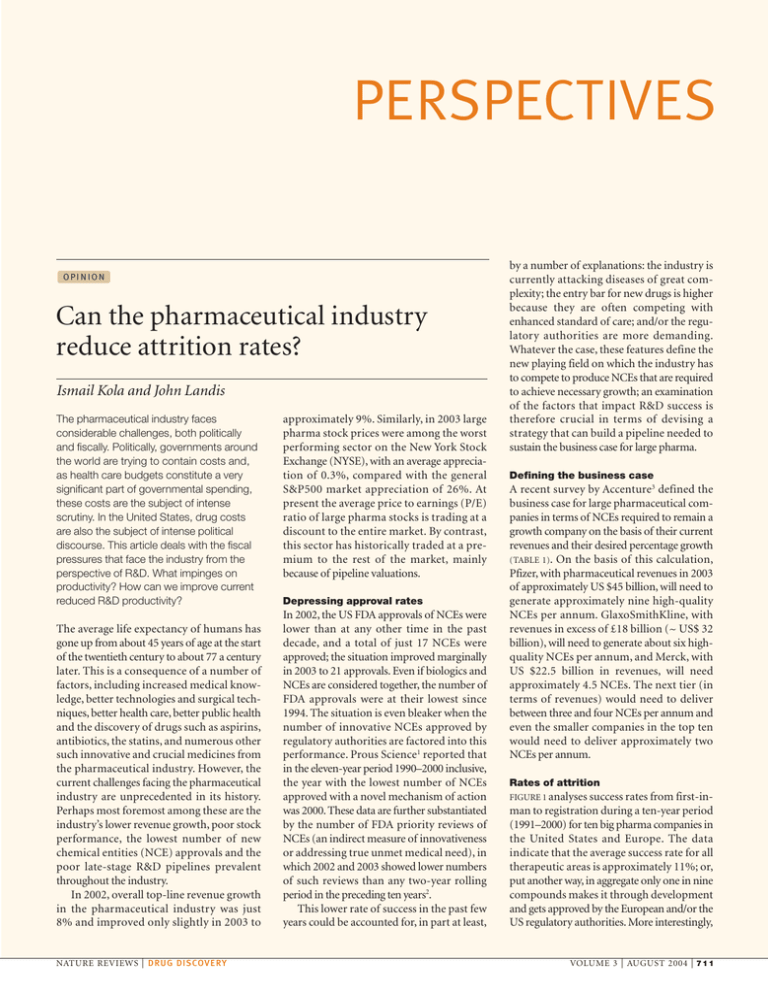
PERSPECTIVES OPINION Can the pharmaceutical industry reduce attrition rates? Ismail Kola and John Landis The pharmaceutical industry faces considerable challenges, both politically and fiscally. Politically, governments around the world are trying to contain costs and, as health care budgets constitute a very significant part of governmental spending, these costs are the subject of intense scrutiny. In the United States, drug costs are also the subject of intense political discourse. This article deals with the fiscal pressures that face the industry from the perspective of R&D. What impinges on productivity? How can we improve current reduced R&D productivity? The average life expectancy of humans has gone up from about 45 years of age at the start of the twentieth century to about 77 a century later. This is a consequence of a number of factors, including increased medical knowledge, better technologies and surgical techniques, better health care, better public health and the discovery of drugs such as aspirins, antibiotics, the statins, and numerous other such innovative and crucial medicines from the pharmaceutical industry. However, the current challenges facing the pharmaceutical industry are unprecedented in its history. Perhaps most foremost among these are the industry’s lower revenue growth, poor stock performance, the lowest number of new chemical entities (NCE) approvals and the poor late-stage R&D pipelines prevalent throughout the industry. In 2002, overall top-line revenue growth in the pharmaceutical industry was just 8% and improved only slightly in 2003 to NATURE REVIEWS | DRUG DISCOVERY approximately 9%. Similarly, in 2003 large pharma stock prices were among the worst performing sector on the New York Stock Exchange (NYSE), with an average appreciation of 0.3%, compared with the general S&P500 market appreciation of 26%. At present the average price to earnings (P/E) ratio of large pharma stocks is trading at a discount to the entire market. By contrast, this sector has historically traded at a premium to the rest of the market, mainly because of pipeline valuations. Depressing approval rates In 2002, the US FDA approvals of NCEs were lower than at any other time in the past decade, and a total of just 17 NCEs were approved; the situation improved marginally in 2003 to 21 approvals. Even if biologics and NCEs are considered together, the number of FDA approvals were at their lowest since 1994. The situation is even bleaker when the number of innovative NCEs approved by regulatory authorities are factored into this performance. Prous Science1 reported that in the eleven-year period 1990–2000 inclusive, the year with the lowest number of NCEs approved with a novel mechanism of action was 2000. These data are further substantiated by the number of FDA priority reviews of NCEs (an indirect measure of innovativeness or addressing true unmet medical need), in which 2002 and 2003 showed lower numbers of such reviews than any two-year rolling period in the preceding ten years2. This lower rate of success in the past few years could be accounted for, in part at least, by a number of explanations: the industry is currently attacking diseases of great complexity; the entry bar for new drugs is higher because they are often competing with enhanced standard of care; and/or the regulatory authorities are more demanding. Whatever the case, these features define the new playing field on which the industry has to compete to produce NCEs that are required to achieve necessary growth; an examination of the factors that impact R&D success is therefore crucial in terms of devising a strategy that can build a pipeline needed to sustain the business case for large pharma. Defining the business case A recent survey by Accenture3 defined the business case for large pharmaceutical companies in terms of NCEs required to remain a growth company on the basis of their current revenues and their desired percentage growth (TABLE 1). On the basis of this calculation, Pfizer, with pharmaceutical revenues in 2003 of approximately US $45 billion, will need to generate approximately nine high-quality NCEs per annum. GlaxoSmithKline, with revenues in excess of £18 billion (~ US$ 32 billion), will need to generate about six highquality NCEs per annum, and Merck, with US $22.5 billion in revenues, will need approximately 4.5 NCEs. The next tier (in terms of revenues) would need to deliver between three and four NCEs per annum and even the smaller companies in the top ten would need to deliver approximately two NCEs per annum. Rates of attrition FIGURE 1 analyses success rates from first-in- man to registration during a ten-year period (1991–2000) for ten big pharma companies in the United States and Europe. The data indicate that the average success rate for all therapeutic areas is approximately 11%; or, put another way, in aggregate only one in nine compounds makes it through development and gets approved by the European and/or the US regulatory authorities. More interestingly, VOLUME 3 | AUGUST 2004 | 7 1 1 PERSPECTIVES Table 1 | NCEs required to achieve specific real growth targets as a function of 2002 revenues* 2002 sales‡ Anticipated sales from current products in 2012 Annual real growth target Sales gap for new products to fill in 2012 Estimated number of NCEs required to fill gap (over ten years) Year 2012 required NCE output $45 billion $30 billion 5% $43.5 billion 75–90 9.5–11 $30 billion $20 billion 5% $29 billion 50–60 6.5–7.5 $20 billion $13.3 billion 5% $19.3 billion 33–40 4.3–5 $15 billion $10 billion 8% $22 billion 40–45 5.5–6.0 6% $17 billion 30–35 4.0–4.5 5% $14.5 billion 25–30 3.25–3.75 4% $12 billion 20–25 2.5–3.0 5% $ 9.67 billion 16.5–20 2.15–2.25 $10 billion $6.67 billion *Adapted from REF. 3. ‡All figures in US $. NCE, New Chemical Entity. the success rates vary considerably between the different therapeutic areas: cardiovascular, for instance, have a ~20% rate of success, whereas oncology and central nervous system (CNS) disorders have ~5% and ~8% success, respectively. Any R&D portfolio, therefore, would need to aggregate the percent success based on the weight of the various therapeutic areas to calculate how many first-in-man studies are needed to approximate the requisite business case for growth. The high rate of attrition in drug development and the need for efficiency, both in terms of real and opportunity costs, becomes even more compelling when one considers where most of the attrition occurs in the pipeline. In 2001, the costs of discovering and developing a drug were of the order of US $804 million4; current estimates are closer to about US $900 million; considerably more of these costs are incurred later in the pipeline, and the vast majority of attrition occurs in full clinical development (Phases IIb and III). FIGURE 2 illustrates the top 10 drug companies’ success and failure rates from 1991 to 2000 across different therapeutic areas. The failure rate of compounds even at the registration stage is 23%; that is, roughly one in four compounds fail after all the trials and the documentation for submission have been completed, thereby incurring the full discovery and development costs and the opportunity costs, which, on average, could be as much as 12 years 10 months (the average time taken for the development of all the drugs that gained approval in 2002)5. In some therapeutic areas, such as woman’s health, the failure rate is as high as 42%, and in oncology it is as high as 30%. Even the rate of failures in Phase III trials — by which stage significant amounts of the costs of discovering and developing a drug would have been incurred — is far too high: approximately 45% of all compounds that enter this phase of full development undergo attrition and in some therapeutic areas, such as oncology, it is as high as Percentage of success 20 15 11% 10 5 0 Arthriris Cardioand pain vascular CNS Infectious Oncology Opthal- Metabolic Urology Women's disease mology disease health All Figure 1 | Success rates from first-in-man to registration. The overall clinical success rate is 11%. However, if the analysis is carried out by therapeutic areas, big differences emerge. The data are from the ten biggest drug companies during 1991–2000. (The companies are AstraZeneca, Bristol-Myers Squibb, Eli Lilly, F. Hoffman-LaRoche, GlaxoWellcome, Johnson & Johnson, Novartis, Pfizer, Pharmacia, Schering-Plough and SmithKline Beecham; data were obtained by Datamonitor in the Pharmaceutical Benchmarking Study). CNS, central nervous system. 712 | AUGUST 2004 | VOLUME 3 59%. Approximately 62% of all compounds that enter Phase II trials undergo attrition, and again the highest rate of attrition at this phase is in the oncology field: more than 70% of oncology compounds fail in this phase. It is therefore crucial that the industry develop and embrace paradigms (such as obtaining proof of concept in man early in development) and methodologies to identify risk preclinically, and to couple this with experimental medicine procedures to interrogate such risks in man. Underlying causes of attrition An examination of the root causes of why compounds undergo attrition in the clinic is very instructive and helps in the identification of strategies and tactics to reduce these rates and thereby improve the efficiency of drug development. The data in FIG. 3 show the reason why compounds undergo attrition and how this has changed over time. In 1991, adverse pharmacokinetic and bioavailability results were the most significant cause of attrition, and accounted for ~40% of all attrition. By 2000, these factors had dramatically reduced as a cause of attrition in drug development, and contributed less than 10%. These data provide further compelling evidence that the industry can identify and remedy the causes of attrition. It might also, however, be that the solving of this problem has significantly shifted the temporal attrition profiles to later stages, because pharmacokinetic/bioavailability failures would have occurred in Phase I mainly and this might now result in compounds progressing to Phases II and III and failing there for other reasons. The major causes of attrition in the clinic in 2000 were lack of efficacy (accounting for approximately 30% of failures) and safety (toxicology and clinical safety accounting for a further approximately 30%). The lack of efficacy might be contributing more significantly www.nature.com/reviews/drugdisc PERSPECTIVES Can success be increased? Several strong strands of evidence indicate that it is possible. First is the fact that different therapeutic areas have different rates of success and this implies that if we understood the inherent factors that make one area successful as compared with another, we could then attack such factors. Second is the finding that biologicals have a higher rate of success from first-in-man to launch — approximately 24%7. It is true that most biologicals have been generated in the areas of immunology and cancer, but the average rate of these two therapeutic areas should even out to ~11% (16% for arthritis and pain and 5% for cancer, based on the data in TABLE 1, which averages to ~11% if the two were in equal parts). Third, licensing-in compounds has a consistently higher probability of success in most studies, at approximately 24%7. This is the case even if the compounds are categorized by the stage that the licensing-out company has categorized them. This phenomenon cannot, therefore, be attributed purely to the fact that the licensing-in companies gather more data or because they usually put the compound at an earlier stage in the pipeline. Fourth, companies with R&D budgets of less than US $400 million also have higher success rates of approximately 18%7. This could partly be explained by the possibility that these smaller companies might be more inclined to work on me-too drugs (which should have a higher rate of success), and that their portfolios could be more skewed towards one therapeutic area or another with a greater probability of success. However, if one considers that many of the biotech companies fall into these categories, that many biotech companies are working in high-attrition-rate therapeutic areas such as cancer, and that NATURE REVIEWS | DRUG DISCOVERY 0 90 10 80 20 70 30 60 40 50 50 40 60 30 70 20 80 10 90 0 100 Phase I Phase II Arthritis and pain management Oncology Women's health b Failure rate (%) Success rate (%) a 100 Cardiovascular Opthalmology All 100 90 80 Success rate (%) to therapeutic areas in which animal models of efficacy are notoriously unpredictive6, such as CNS and oncology, both of which have relatively higher failure rates in Phase II and III trials. In the case of oncology, small Phase II trials looking at tumour regression in small cohorts of patients with different tumour types does not always translate to outcomes subsequently obtained in larger Phase III trials. Nevertheless, in general, failures due to lack of efficacy and safety demonstrate the need for the development of more predictive animal models where possible and, more importantly, the need to develop experimental medicine paradigms that are more predictive of outcomes and to carry out such proof-of-concept clinical trials much earlier in development. 70 60 50 40 30 20 10 0 I II III Reg. App. Stage of development many of these companies are indeed working on innovative mechanisms of action, then clearly this cannot be the whole explanation. The rate of attrition of compounds with novel mechanisms of action is higher than that of those with previously precedented mechanisms of action (a precedented mechanism of action is defined as one hitting a therapeutic target that a drug in the market place hits, or which has shown proof of concept in late clinical trials). Last, even comparable large companies with extensive portfolios that would average out the differences in success between different therapeutic areas, and therefore portfolio success, have different probabilities of success. For instance, data from the 2002 Certified Medical Representatives Institute survey shows that the success rate that Merck enjoyed from first human dose to market was approximately twofold greater than the aggregate of the six companies in the same cohort with R&D budgets of >US $2 billion per annum8. On the other hand, in a briefing to analysts on 17 June 2003 Pfizer’s current President of Research and Development, John La Mattina, was quoted as saying “Right now, only one in 25 early candidates survives to become a prescribed medicine. We think we can improve those odds to one in ten and greatly enhance our ability to bring new medicines to patients Phase III Registration Central nervous system Metabolic disorders Infectious disease Urology Figure 2 | Success rate by phase of development and by therapeutic area. a | Data are shown as percent success or percent attrition (second X axes) of compounds entering that particular phase of development by certain therapeutic areas and by the total aggregate for that particular phase of development. The data clearly show that different therapeutic areas have greatly different success or attrition rates, and that significant attrition occurs late in the pipeline. b | Shows the percentage rate of success of compounds entering first in man that progress to subsequent development phase. App, approval; Reg, registration. around the world. ”; Pfizer’s India Homepage states that “approximately 1 out of every 15 drug candidates entering development completes phase III evaluation and obtains approval, ” both suggesting that their rate of attrition might be 93–96%. These five factors therefore provide compelling evidence that the rate of attrition could be significantly reduced and that drug development per se does not have this current high attrition rate as an inherent constraint. Indeed, it points to the idea that a systematic evaluation of the science, strategy and processes currently used in drug development merit rigorous evaluation, critical appraisal and modification to fulfil the onerous business case demanded by our patients, shareholders, consumers and governments worldwide. How can attrition be reduced? Several companies in the industry are now beginning to take on this problem and are starting to make progress. Below we propose some approaches that are likely to be valuable, but this is clearly not an exhaustive list. It is important that the mindset of reducing attrition in development should be in place from the earliest stages of discovery. For instance, building the need to get very strong evidence for proof of mechanism into the discovery paradigm is crucial, VOLUME 3 | AUGUST 2004 | 7 1 3 PERSPECTIVES Attrition for each criterion (%) 50 1991 2000 40 30 Future perspectives 20 10 0 Clinical safety Efficacy Formulation PK/ Commercial Toxicology bioavailability Cost of goods Unknown/ other Figure 3 | Reasons for attrition (1991–2000). PK, pharmacokinetics. and therefore showing that modulation of a target in a specific or important disease pathway might reduce the attrition of a large percentage of compounds that fail because of lack of efficacy. The development of imatinib (Gleevec; Novartis), for example, was based on the targeting of a very specific lesion (the BCR-ABL chromosomal translocation protein-product or Philadelphia chromosome) that occurs in chronic myelogenous leukaemia. We have, in a similar manner, provided very strong evidence that inhibition of β-secretase inhibits the production of amyloid-β in knockout mice9 and that cathepsin K is involved in bone resorption (further compelling proof of mechanism is provided by humans with pycnodysostosis10,11). However, we will have to await approval of therapeutics aimed at these latter two mechanisms to see whether drug approvals are eventually obtained — for example, cathepsin K is in Phase II trials and the impact of this approach on attrition is still to early to fully evaluate. A second method of reducing attrition is to eliminate compounds that have mechanismbased toxicity; this risk can be rigorously interrogated during discovery using tools such as gene knockouts and RNA interference, and, crucially, during preclinical development in toxicity testing. Additional tools such as transcriptional profiling can also affect attrition due to toxicity by giving specific gene-signature readouts that are predictive of toxicities obtained by previous compounds targeting specific molecular targets that have failed, and/or molecular signature algorithms that have been trained from preclinical toxicity studies. Third, an important clinical tool that can be used is to identify biomarkers that signal correct dosing and whether the specific molecular target has been hit in early proof-of-concept clinical trials. 714 much earlier in the drug discovery process, and/or by better due diligence with respect to competitor development programmes and the likelihood of true differentiation from such drugs that might be ahead in development. | AUGUST 2004 | VOLUME 3 Fourth, and most important, is the design of proof-of-concept clinical trials during first-in-man studies. This has the distinct advantage of providing evidence in man that the molecular target is being hit and that hitting such a target gives the anticipated physiological response. Appropriately designed proof-of-concept studies (or experimental medicine paradigms) could reduce attrition due to lack of efficacy mostly seen in later development, and also have the distinct advantage of allowing attrition to occur earlier, which is beneficial both in terms of real and opportunity costs. This is likely to be important given that lack of efficacy accounts for about 30% of attrition in this study. Fifth, another important tool is the use of appropriate animal models for efficacy testing in preclinical studies. It is interesting that oncology and CNS —two therapeutic areas with very high attrition rates in the data provided here — are also the areas in which animal models are not very predictive of the true human pathophysiology. For example, most pharmaceutical companies still use xenograft models for oncology testing, in which a tumour cell line that might have little relevance to the tumour in vivo is injected into a nude mouse (which does not resemble the immunology of the host; nor does the artificial location of the tumour significantly resemble what happens in vivo during tumorigenesis). The use of appropriate genetic models (for example, transgenic and gene knockout animals) of tumorigenesis might be more pathophysiologically relevant. Last, another area in which attrition can be reduced is the discontinuation of compounds for commercial reasons either by gaining alignment between the research, development and marketing functions The demands on pharmaceutical companies to meet their business objectives, as well as the demands of consumers for cost containment of prescription medicines, is forcing the industry to think about ways that efficiencies can be achieved. A particular emphasis is being placed on R&D because of the relatively dry late-phase pipelines, the spiralling costs of drug discovery and drug development, and the patent expirations of major blockbusters innovated in the past two decades. These pressures inevitably lead to a healthy evaluation of the science, strategies and processes involved in drug development, because the rate of attrition in drug development is simply too high, which makes the R&D process inefficient; efficiency and sustained profitability by the pharmaceutical industry are important for reinvestment in further R&D so that therapies for debilitating human diseases can continue to be developed and the price of medications contained. This inefficiency becomes even more acute when one considers the number of compounds that undergo attrition in preclinical research, and that only three out of every ten drugs that makes it to market recover the original investment made in them. Factors that clearly affect attrition rates will lead to a more efficient industry and will benefit shareholders, and, more importantly, patients and the community. The industry will be forced to focus on attrition rates to balance the costs of drug development, to explore cost containment measures while still investing significantly in R&D, and to continue to generate shareholder value. Scientific and technological innovations that affect efficacy and safety (factors that most significantly contribute to attrition in the clinic) will have to be addressed. These include more appropriate animal models; biomarkers that can report the hitting of the molecular target in doseranging, efficacy and toxicity studies; and a new paradigm for drug development that will give early readouts for proof of concept and one that will allow attrition to occur much earlier. We believe that governments and consumers want to reward truly innovative drugs, and/or those that are genuinely differentiated www.nature.com/reviews/drugdisc PERSPECTIVES from existing drugs and that address a true unmet medical need; this provides a tremendous incentive for the pharma industry to conduct R&D in this arena, and this in itself could affect R&D productivity. Drugs that target novel mechanisms have higher attrition rates12, but a combination of better-validated preclinical targets that have significant preclinical proof of principal, and the scientific and technological innovations that positively affect efficacy and safety of drugs discussed earlier in this article, can mitigate such attrition risks. It is clear that in the twentieth century the pharmaceutical industry has had significant positive impact on the health and longevity of humans across the globe, but the early twenty-first century will demand both great effectiveness and efficiency from the industry, and it is therefore vital that the industry rapidly gears up to meet these demands. NATURE REVIEWS | DRUG DISCOVERY Ismail Kola, Ph.D. (Med), is Senior Vice-President of Basic Research at Merck Research Labs, 126 East Lincoln Avenue, Rahway, New Jersey 07075, USA. John Landis , Ph.D., is Senior Vice-President Pharmaceutical Sciences and Compliance Clinical Sciences at Schering-Plough Research Institute, 2000 Galloping Hill Road, Kenilworth New Jersey 07033, USA. Correspondence to I.K. e-mail: ismail_kola@merck.com doi:10.1038/nrd1470 1. 2. 3. 4. 5. 6. 7. Kola, I. & Rafferty, M. New technologies that may impact drug discovery in the 5–10 year timeframe workshop. 2002 Biomed. Expo Ann Arbor Michigan (data derived from Prous Science, Drugs News Prospect (2002). Franz, S. 2003 approvals: a year of innovation and upward trends. Nature Rev. Drug Discov. 3, 103–105 (2004). Accenture Consulting. High performance drug discovery: an operating model for a new era. Accenture (2001). DiMasi, J. A., Hansen, R. W. & Grabowski, H. G. The price of innovation: new estimates of drug development costs. J. Health Econ. 22, 151–185 (2003). Fearn, C. J. IMS Health. The World Pharmaceutical Market Presented at the Strategic Management Review, Australia, 19–20 June (2002). Booth, B., Glassman, R. & Ma, P. Oncology’s trials. Nature Rev. Drug Discov. 2, 609–610 (2003). Benjamin, G. A. & Lumley, C. E. Industry Success Rates 2003 Including Trends in Success Rates CMR Report Number 03–202 R (CMR International Surrey, UK, 2003). 8. Van den Haak, M. A., Palachandran, J. & Benjamin, G. A. Performance Metrics in Global Pharmaceutical R&D, Company specific review 2002 for Merck & Co. (CMR International, Surrey, UK, 2003). 9. Roberds, S. L. et al. BACE knockout mice are healthy despite lacking the primary β-secretase activity in brain: implications for Alzheimer’s disease therapeutics. Hum. Mol. Genet. 10, 1317–1324 (2001). 10. Gowen, et al. Cathepsin K knockout mice develop osteopetrosis due to a deficit in matrix degradation but not demineralization. J. Bone Miner. Res. 14, 1654–1663 (1999). 11. Lazner, F., Gowen, M. & Kola, I. An animal model for pycnodysostosis: the role of cathepsin K in bone remodeling. Mol. Med. Today 5, 413–414 (1999). 12. Ma, P. & Zemmel, R. Value of novelty? Nature Rev. Drug Discov. 1, 571–572 (2002). Acknowledgements We wish to acknowledge Datamonitor for the assembly of data (Pharmaceutical R&D Benchmarking Forum) used in this study. Competing interests statement The authors declare competing financial interests: see Web version for details.. Online links FURTHER INFORMATION PhRMA: http://www.phrma.org/ Access to this interactive links box is free online. VOLUME 3 | AUGUST 2004 | 7 1 5


